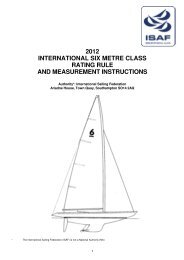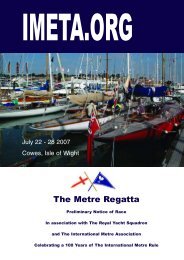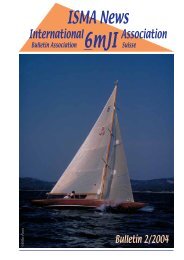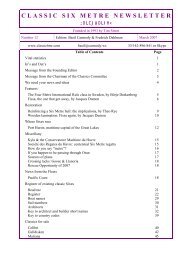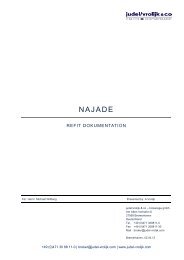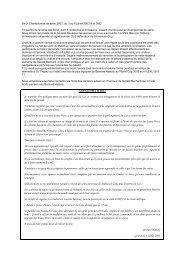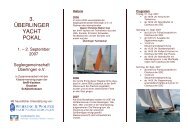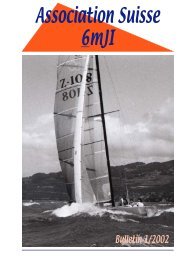ISMA News - Association Suisse 6mJI
ISMA News - Association Suisse 6mJI
ISMA News - Association Suisse 6mJI
Create successful ePaper yourself
Turn your PDF publications into a flip-book with our unique Google optimized e-Paper software.
<strong>ISMA</strong> <strong>News</strong> International <strong>6mJI</strong> <strong>Association</strong> Bulletin 1/2004<br />
SAIL RULE FOR THE CLASSICS<br />
Inspired by the discussion during the past year about the proposed sail rule on the classic web site, http://<br />
www.classic6metre.info/, I want to present some thoughts for an alternative suggestion for a new sail rule for the classics.<br />
My emphasis is on cost reduction, let´s have cost efficient rig, hardware and sails in order to afford to keep the original<br />
hulls in shape.<br />
1. MATERIALS. Many arguments have been brought up in the discussion in favour of more modern materials than<br />
dacron. Looked from the pre-war perspective, dacron would be as modern as other synthetics, even the color is<br />
probably much brighter white than the orinal cotton sails were – so maybe the question of classic materials is<br />
irrelevant.<br />
2. COSTS. The cost of sails comes firstly from the strive to keep the original shape of the sail unaltered and from<br />
making the sail as light as possible at the same time – this leads to expensive high tech sails with often short racing<br />
life time expectancy. Secondly the cost comes from the number of sails in the wardrobe.<br />
3. SAIL RULE. The following aims should be included in the rule as a way to limit the costs:<br />
- limiting the number of sails (eg. 1 mainsail, 3 foresails, 2 spinnakers) would limit the total cost of the sail wardrobe<br />
- minimum cloth weights for different sails would make the use of the most expensive materials unnecessary and<br />
lengthen the racing life time of them<br />
- introducing other ways to lenghthen the life time of sails, eg. smaller roaches, longer battens in mainsails<br />
- limiting the number of new sails acquired per season would further limit the costs (works in the Etchells class)<br />
I hope that we can continue the discussion on both this matter and other questions regarding the classics at the classic<br />
website and hopefully find a compromise for a new rule that the majority of the class would be willing to accept. I believe<br />
that this way we will get bigger fleets and more fun and tighter racing at the future international 6 metre regattas.<br />
Tapio Lehtinen<br />
FIN 53, May Be IV<br />
Comment to the Sail Rule proposal for the Classic’s by Ian Howlett:<br />
Thoughts on Possible Sail Rules for Classics<br />
There has been considerable discussion on the idea of reducing the costs of sails by only allowing woven Dacron (<br />
polyester ) of certain defined characteristics to be used for Classic sails .<br />
I should point out that I am not a sailmaker but have experience of a number of different Classes so hopefully these ,<br />
which are my own personal thoughts , will be useful to those who will have to decide such things .<br />
Perhaps the way to tackle the problem is to look at the underlying issues . Once these are identified and a strategy<br />
developed to achieve the intended objectives , a dacron mainsail might become just as desirable ( fast ) a sail as one made<br />
of the so called exotics - so owners could have free choice of materials<br />
„Kirlo „ in 1982 ( European’s in Helsinki ) was probably the last modern to use an 8oz dacron main ( 1982 North<br />
Alameda ) as her primary mainsail to win a major regatta so I do have some experience of this type . This , with its<br />
traditional length battens ) is still a fine sail after a rest but begins to fade if the wind is up , as a Regatta goes on . This<br />
means presumably that it is overgirth for its material and would be a more serviceable sail with the roach reduced or with<br />
longer battens . Interestingly it is feels a better sail than its 1981 equivalent - and this is likely to be a difference in the<br />
material - and this variability would surely be a big problem for a „ Dacron only rule „ .<br />
As I see it the main issues are :-<br />
Longevity<br />
Cost - which is linked to longevity .<br />
Aesthetics<br />
Question .. Could it be that it is a mistake to use the same Rules for Modern and Classic Boats ?<br />
These appear to be the obvious For and Against points ..<br />
25



